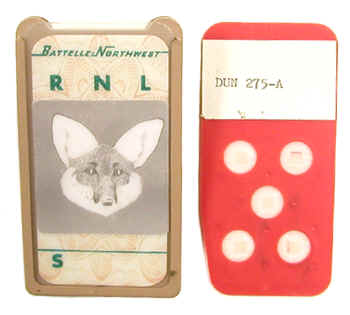Prototype Hanford TLD Badge (ca. 1972)

This is an early 1970s prototype of what was known as Hanford's "multipurpose" TLD dosimeter. Later, it became known as the "compliance" dosimeter. The badge employs five LiF TLD chips for evaluating beta, gamma and neutron exposures. These TLDs only respond to slow (low energy) neutrons, whereas most exposures are to neutrons of higher energy. For the high energy (fast) neutrons to be measured, they are slowed down and scattered off the body. A dosimeter that relies on the body to slow down and reflect neutrons is referred to as an albedo dosimeter. The photograph shows the badge with the red plastic insert removed. The five LiF chips are sandwiched between two thin sheets of teflon and suspended in holes in the plastic insert.
Since LiF has an effective atomic number very similar to that of air (or tissue), it does not over-respond to low energy photons. As such, it is not necessary for the badge to employ the same type of selective filtration used in a film badge to account for an over-response.
During the evaluation of the prototype, a card with a fox face on it was inserted into the badge to simulate the effect on the TLD's response of the security ID photo that would be used in a real badge.
Essentially the same badge design was used at Hanford into the 1990s.
Size: 1.75" x 3.25"
Donated by Ron Kathren.
Reference
Ron Kathren, personal communication.
